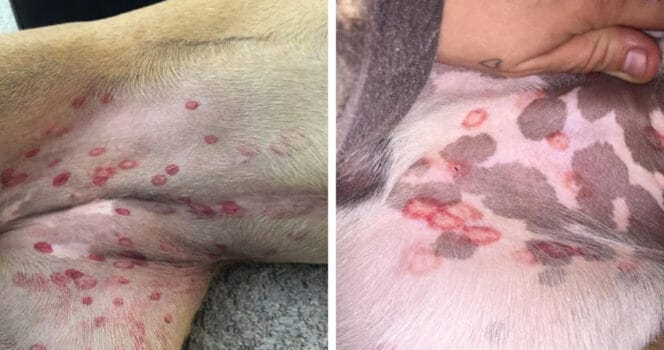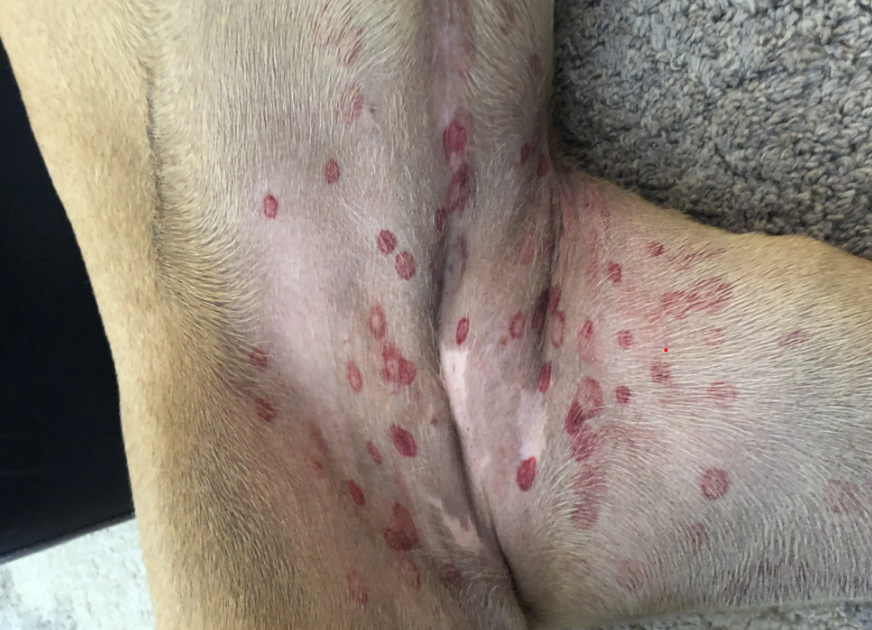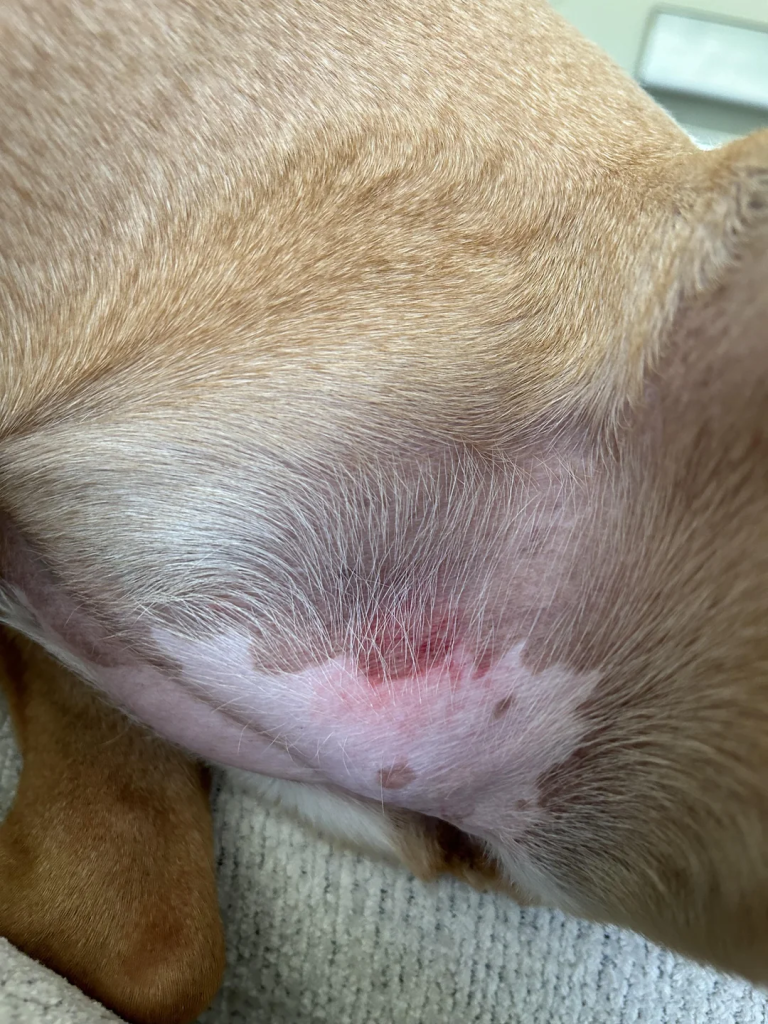Have you ever spotted angry-looking, red rings on your pup’s stomach and felt your heart race? You’re not alone. Many dog parents panic, assuming the worst—fleas, ticks, allergies, or worse. But here’s the scoop: in most cases, these ominous spots are just fly bites, and your furry friend is probably fine.

How Fly Bites End Up on Your Dog’s Belly
Remember the last time you lay in tall grass and got ambushed by bugs? Dogs do it all the time. When your pooch rolls around in spring meadows, they can attract hungry flies that leave behind small, red welts. According to Morinville Veterinary Clinic in Alberta, this specifically happens during a few weeks each spring when these flies swarm the grass—and then they vanish until next year.
Spotting the Culprits: Black Flies Explained
Black flies are tiny blood-suckers common in northern climates across North America. They thrive in damp, grassy areas, and your dog’s soft underbelly is an all-you-can-eat buffet. These bites usually appear as neat, round welts that, although they look alarming, seldom bother your dog.
Video: What Causes Red Circles On Dog’s Belly/ Dog skin Infection
Real Talk from the Experts
“We’re getting more and more calls about red bites on dogs’ stomachs,” posted Troy Macdiarmid of Morinville Veterinary on Facebook. “These are a type of fly bite… They heal quickly on their own and do not require any treatment.”
Michael San Filippo, spokesperson for the American Veterinary Medical Association, backed this up: “Black fly bites on dogs are typically harmless. However, if you notice changes in behavior or if the bites persist, it’s wise to check in with your vet.”
When to Worry: Other Possible Causes
Fly bites are usually innocent, but identical marks can signal issues that merit attention:
- Allergic Reactions: Does your dog scratch relentlessly? Hives or widespread redness could mean an allergy to food, pollen, or even flea saliva.
- Other Pests: Mites, ticks, or fleas can leave clustered bites that itch and swell. A closer look under your dog’s coat might reveal tiny hitchhikers.
- Skin Infections: Bacterial or fungal infections sometimes start as small red patches and can spread if untreated.
Checking Your Dog: A Quick DIY Skin Exam

- Run Your Hands: Gently part the fur on the belly, behind the ears, and around the base of the tail.
- Look for Patterns: Fly bites tend to form neat circles. Flea bites are more random clusters.
- Assess Behavior: Is your pup licking, scratching, or whining? An irritated dog might need a vet’s attention.
Preventing Fly Bites: Simple Tips That Work
- Mow the Lawn: Short grass means fewer hiding spots for biting flies.
- Limit Rolling in Wet Grass: Monitor outdoor playtime when flies are most active—typically early morning and dusk.
- Use Pet-Safe Repellents: Look for vet-approved sprays or wipes designed to deter flies without harming your dog.
Conclusion: Stay Calm and Carry On
Those red, circular welts can make your heart skip a beat, but in most cases, they’re just harmless fly bites that clear up on their own. Understanding the habits of black flies and giving your dog a quick at-home exam will save you stress—and unnecessary vet bills. Of course, if you ever spot odd behavior or persistent lesions, trust your instincts and consult your veterinarian. After all, you know your dog better than anyone—and a quick check-in never hurts!
Vet Explains the Mystery Behind Red Marks on Dogs’ Stomachs
Why Your Dog’s Belly Is Showing Angry-Red Spots
If you’ve ever noticed little red circles dotting your dog’s belly and felt immediate concern, you’re in good company. We’ve all been there, imagining every worst-case scenario. But the reality is often simpler: these red bites are typically harmless fly bites, not a looming health crisis.
The Grass-Rolling Connection
Dogs love to roll in grass—that’s a fact. Unfortunately, that playful behavior exposes them to hungry flies, especially in early spring. Morinville Veterinary Clinic in Alberta, Canada, reported a flood of calls about red welts on dogs’ stomachs. Turns out, these marks coincide with seasonal fly activity and almost always resolve themselves.

Meet the Offenders: Black Flies 101
Black flies are tiny, agile insects that swarm moist, grassy habitats. When your dog lies down for a belly scratch, these flies see an opportunity and deliver a quick bite. The result? A neat circle of red raised skin. While they look dramatic, most pups don’t even notice them.
Insights from Veterinary Pros
“Dogs get these from laying in grass,” said Troy Macdiarmid on the clinic’s Facebook. “They look terrible, but usually do not bother the dogs.”
And Michael San Filippo of the AVMA added, “Although black fly bites are generally harmless, any persistent or worrisome skin changes warrant a vet visit.”
Beyond Fly Bites: Other Red-Mark Culprits
Even though fly bites are common, similar symptoms can arise from different issues:
- Flea Infestations: Flea bites are often scattered and intensely itchy. If you spot small black specks (flea dirt), it’s time for a flea comb check.
- Allergic Dermatitis: Dogs can be allergic to food, pollen, or chemicals. Allergic reactions sometimes mimic bite patterns but usually involve more itchiness and inflammation.
- Skin Conditions: Bacterial or yeast infections can cause red, circular lesions that might ooze or crust—definitely a sign to call your vet.
Performing a Home Skin Assessment
Video: How to Identify a Bug Bite and What to Do With It
- Visual Inspection: Part the fur on the tummy and inspect for uniform circular bites versus irregular patches.
- Behavioral Clues: Does your dog flick its paws at its belly or constantly chew? Fly bites rarely lead to frantic scratching.
- Duration Check: Fly bites fade within a week. Marks that linger or worsen deserve professional attention.
Practical Prevention Strategies
- Keep Grass Trimmed: Shorter grass reduces fly hiding spots.
- Restrict Grass-Roll Time: If flies swarm, move play to paved areas.
- Protective Barriers: Dog shirts or belly pads can shield sensitive skin during peak fly season.
When to Call the Vet
If your dog’s bite marks:
- Bleed or ooze
- Spread beyond the belly
- Trigger intense scratching or discomfort
…then it’s safer to seek veterinary advice. After all, a quick check can prevent complications down the road.
Conclusion: No Need to Panic
Next time you spot red circles on your dog’s stomach, take a deep breath. Most likely, they’re just fleeting fly bites that clear up in days. By keeping an eye on your pet’s behavior and performing a simple at-home exam, you’ll save yourself stress—and avoid unnecessary expenses. And if anything feels “off,” you know your vet is just a call away. Trust your gut and give your canine companion the care they deserve!


